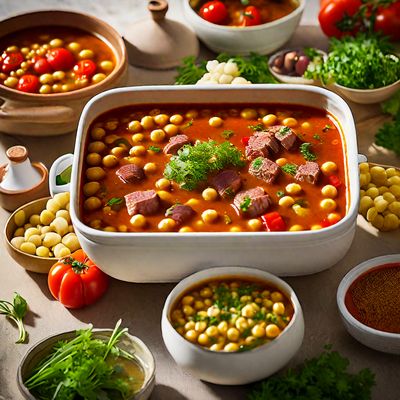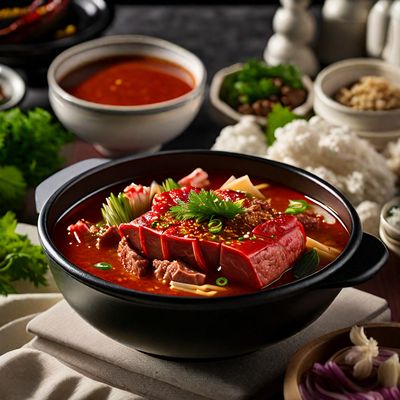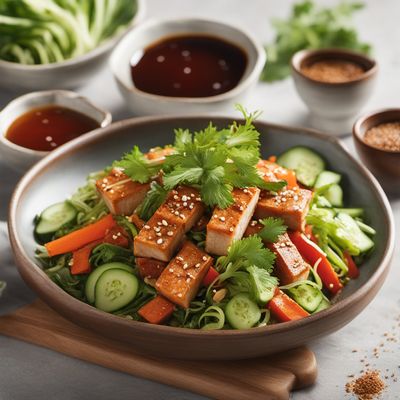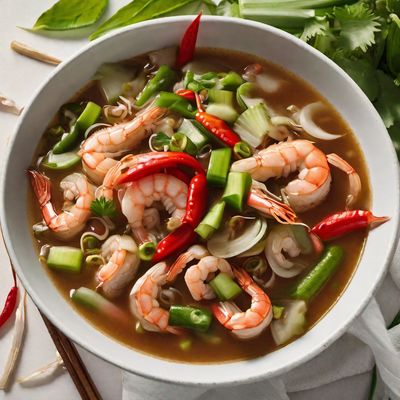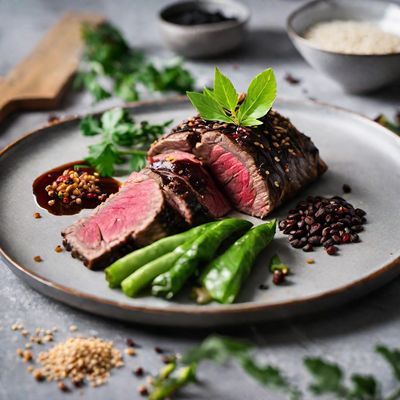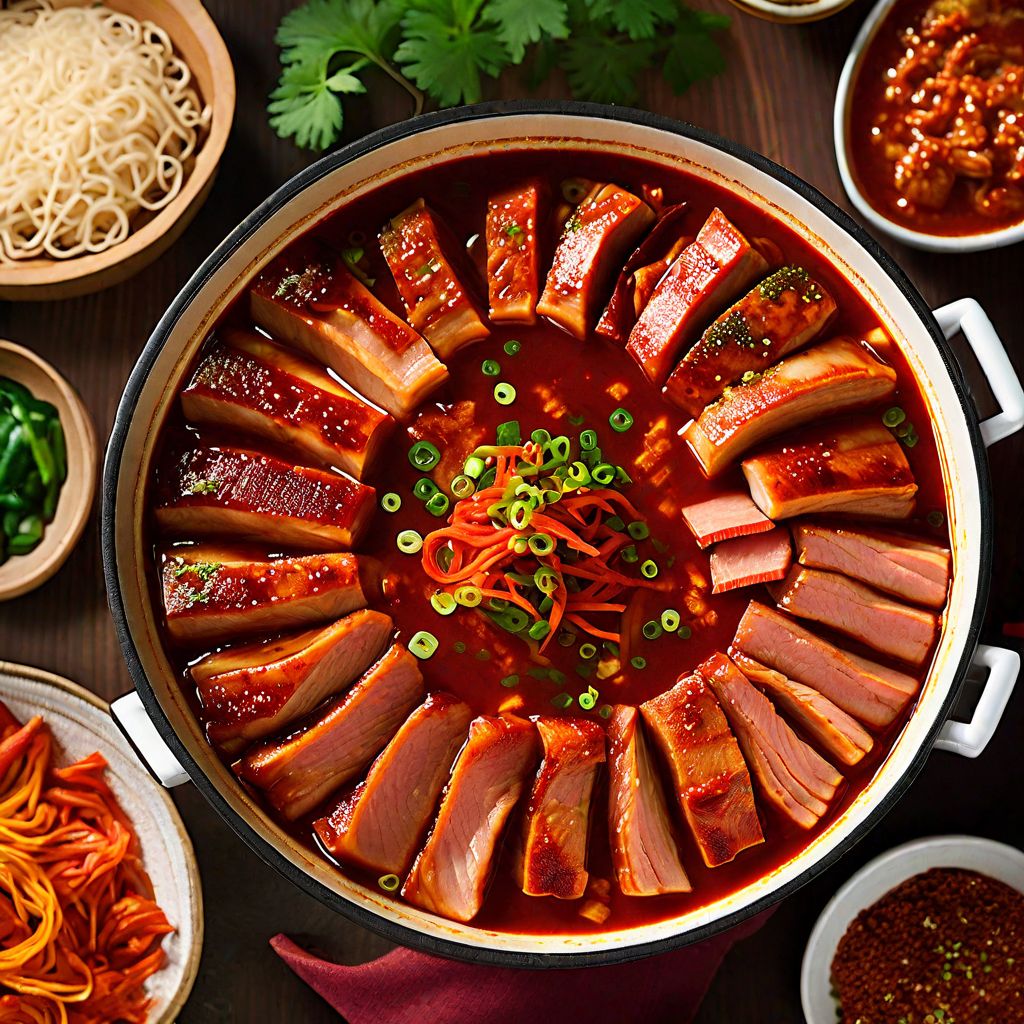
Recipe
Sichuan-style Budae Jjigae
Spicy and Savory Sichuan Hot Pot Stew
4.8 out of 5
In the vibrant world of Sichuan cuisine, we bring you a delightful twist on the classic Korean dish, Budae Jjigae. This Sichuan-style adaptation infuses the rich flavors of Sichuan cuisine into the comforting and hearty stew. Get ready to experience the fiery and numbing sensation that Sichuan cuisine is famous for, combined with the umami-packed ingredients of Budae Jjigae.
Metadata
Preparation time
20 minutes
Cooking time
30 minutes
Total time
50 minutes
Yields
4 servings
Preparation difficulty
Medium
Suitable for
Spicy food lovers, Meat enthusiasts, Low-carb diets, High-protein diets, Comfort food seekers
Allergens
Soy, Wheat (from the Chinese sausages)
Not suitable for
Vegetarian, Vegan, Gluten-free, Dairy-free, Paleo
Ingredients
While the original Budae Jjigae is known for its fusion of Korean and American flavors, this Sichuan-style adaptation takes inspiration from the bold and spicy flavors of Sichuan cuisine. We incorporate Sichuan peppercorns, chili bean paste, and other traditional Sichuan ingredients to create a unique and fiery twist on this beloved stew. We alse have the original recipe for Budae jjigae, so you can check it out.
-
200g (7 oz) sliced pork belly 200g (7 oz) sliced pork belly
-
200g (7 oz) boneless chicken thighs, cut into bite-sized pieces 200g (7 oz) boneless chicken thighs, cut into bite-sized pieces
-
150g (5.3 oz) Chinese sausages, sliced 150g (5.3 oz) Chinese sausages, sliced
-
150g (5.3 oz) firm tofu, cubed 150g (5.3 oz) firm tofu, cubed
-
100g (3.5 oz) kimchi, chopped 100g (3.5 oz) kimchi, chopped
-
100g (3.5 oz) enoki mushrooms 100g (3.5 oz) enoki mushrooms
-
2 tablespoons Sichuan chili bean paste 2 tablespoons Sichuan chili bean paste
-
2 tablespoons soy sauce 2 tablespoons soy sauce
-
1 tablespoon Sichuan peppercorns 1 tablespoon Sichuan peppercorns
-
1 tablespoon minced garlic 1 tablespoon minced garlic
-
1 tablespoon vegetable oil 1 tablespoon vegetable oil
-
1 teaspoon sugar 1 teaspoon sugar
-
4 cups (950ml) chicken broth 4 cups (950ml) chicken broth
-
2 cups (470ml) water 2 cups (470ml) water
-
2 green onions, chopped 2 green onions, chopped
-
Fresh cilantro, for garnish Fresh cilantro, for garnish
Nutrition
- Calories (kcal / KJ): 450 kcal / 1884 KJ
- Fat: 30g (total), 10g (saturated)
- Carbohydrates: 10g (total), 3g (sugars)
- Protein: 35g
- Fiber: 2g
- Salt: 2g
Preparation
-
1.Heat vegetable oil in a large pot over medium heat. Add minced garlic and Sichuan peppercorns. Stir-fry for 1 minute until fragrant.
-
2.Add sliced pork belly and chicken thighs to the pot. Cook until browned.
-
3.Stir in the Sichuan chili bean paste and soy sauce. Cook for another 2 minutes.
-
4.Add kimchi, Chinese sausages, tofu, and enoki mushrooms to the pot. Stir well to combine.
-
5.Pour in the chicken broth and water. Bring to a boil, then reduce heat and simmer for 15 minutes.
-
6.Add sugar and adjust seasoning according to taste.
-
7.Serve the Sichuan-style Budae Jjigae hot, garnished with chopped green onions and fresh cilantro.
Treat your ingredients with care...
- Pork belly — For a leaner option, you can use pork loin instead of pork belly. However, the richness of pork belly adds a delicious flavor to the stew.
- Sichuan peppercorns — Toast the peppercorns in a dry pan before using to enhance their aroma and flavor.
- Kimchi — If you prefer a milder taste, rinse the kimchi before adding it to the stew.
- Chinese sausages — You can substitute Chinese sausages with any other cured sausages of your choice.
- Enoki mushrooms — Trim the tough ends of the enoki mushrooms before adding them to the stew.
Tips & Tricks
- Adjust the amount of Sichuan chili bean paste according to your spice tolerance.
- If you prefer a thicker stew, dissolve 1 tablespoon of cornstarch in water and add it to the pot during the last few minutes of cooking.
- Feel free to add other ingredients such as fish balls, shrimp, or vegetables to customize your Sichuan-style Budae Jjigae.
- Serve the stew with steamed rice or noodles for a complete meal.
- Leftovers can be stored in the refrigerator for up to 3 days and taste even better the next day.
Serving advice
Serve the Sichuan-style Budae Jjigae piping hot in individual bowls. Accompany it with steamed rice or noodles to soak up the flavorful broth. Provide chopsticks and spoons for a traditional dining experience.
Presentation advice
Garnish the stew with a sprinkle of chopped green onions and fresh cilantro to add a pop of color. Serve it in a traditional Chinese hot pot or a large ceramic bowl to showcase the vibrant ingredients and rich broth.
More recipes...
For Budae jjigae » Browse all
For Korean cuisine » Browse all
More Korean cuisine dishes » Browse all

Hobak namul
Zucchini Namul
Hobak namul is a Korean side dish made with blanched zucchini and a soy sauce-based dressing.

Bosintang
Dog meat soup
Bosintang is a Korean soup made with dog meat.

Hongeojjim
Spicy Skate Stew
Hongeojjim is a Korean dish made with skate fish that is marinated and steamed. It is a popular dish in Korean cuisine and is known for its tender...

